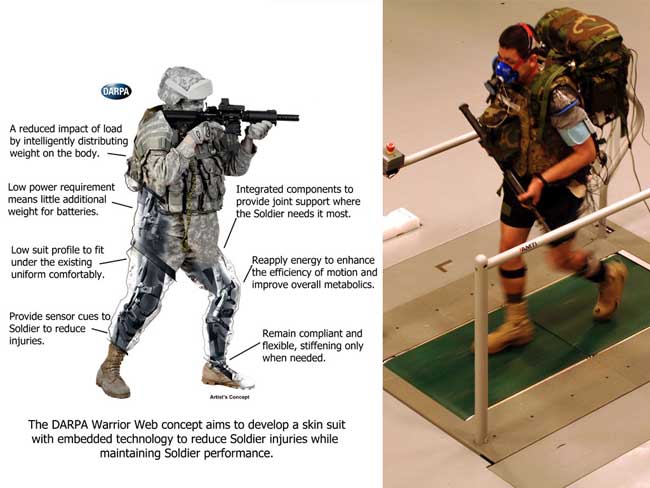
The US Special Operations Command is looking for revolutionary new gear assisting troops in exceeding human performance in combat. The idea sounds similar to a science fiction tale, but if the command will be successful in its quest – this time it may be real. The command has posted a Request For Information (RFI) to government research centers, academy and industry, to provide information that could contribute to the evolution of the Tactical Assault Light Operator Suit, or TALOS. Defense-Update reports.
The kit will be applied as part of a futuristic uniform suit, using powered exoskeleton providing the wearer superhuman strength or ultra protection with full-body ballistic armor. Using wide-area networking, wearable computers and antennae, operators will have more situational awareness, through bionic visual and aural sensing. Other technologies that could be implemented include non-visual means of information display, including the utilization of cognitive thoughts and immersive displays depicting personalized information over the surrounding environment. health and medical monitoring features could employ embedded monitoring, oxygen supply systems, wound stasis and electromechanical compensation. Thermal and energy generation and management are also likely to be explored.

SOCOM issued the RFI on the US Government Federal Opportunity Bulletin board, and is expecting submissions by June 15. The command expects submissions of technologies already in development (TRL 5 or higher) that could be demonstrated in a short term. As much as this vision seems futuristic, SOCOM is looking for practical, near-term capabilities. typical of the command’s no nonsense attitude, the technologies selected for demonstrations should be integrated to form an initial capability within twelve months. A secondary goal is to determine the feasibility of fielding objective capabilities within three years. Such technologies could be submitted by research and development organizations, private industry, government labs and academia as well as individuals.
One of the responders is the U.S. Army Research, Development and Engineering Command (RDECOM), is one of the government establishments that have responded to the call. “There is no one industry that can build it,” said SOCOM Senior Enlisted Advisor Command Sgt. Maj. Chris Faris during a panel discussion at a conference at MacDill Air Force Base, Fla. The demonstrations of relevant technologies would take place a month later, on July 8-10, in Florida.
TALOS will have a physiological subsystem that lies against the skin that is embedded with sensors to monitor core body temperature, skin temperature, heart rate, body position and hydration levels. The body armor could consist of magnetorheological fluids – also known as ‘liquid body armor‘ – that transforms from liquid to solid in milliseconds when a magnetic field or electrical current is applied. Though still in development, this technology will likely be submitted to support TALOS.
“[The] requirement is a comprehensive family of systems in a combat armor suit where we bring together an exoskeleton with innovative armor, displays for power monitoring, health monitoring, and integrating a weapon into that – a whole bunch of stuff that RDECOM is playing heavily in,” said. Lt. Col. Karl Borjes, an RDECOM science advisor assigned to SOCOM. “RDECOM cuts across every aspect making up this combat armor suit,” Borjes said “It’s advanced armor. It’s communications, antennas. It’s cognitive performance. It’s sensors, miniature-type circuits. That’s all going to fit in here, too.”
One of the programs that could be considered for this quest is ‘Warrior Web’, an exoskeleton capability currently managed by the Defense Advanced Research Agency (DARPA) and the U.S. Army, exploring a new kit enabling soldiers to reduce fatigue and potential injuries caused by excessive loads they carry on dismounted operations. DARPA’s Warrior Web is a soft, lightweight under-suit that will augment the work of the Soldiers’ own muscles, to significantly boosting endurance, carrying capacity and overall warfighter effectiveness–all while using no more than 100 Watts of electrical power.
The Warrior Web program consists of two related program tasks – the first task currently underway aims to develop a mix of core ‘critical technologies’, deemed criticalCurrently underway, Task A seeks to develop a mix of core technologies deemed critical for the program’s success. On the second phase, scheduled to commence in fall 2013 researchers will develop and fabricate an integrated suit that would eventually undergo real-world testing to evaluate its performance.
A prototype suit is already undergoing testing at the U.S. Army Research Laboratory Human Research and Engineering Directorate (ARL HRED), evaluating various prototype devices. The testing evaluates how each prototype incorporates different technologies and approaches to reduce forces on the body, decrease fatigue, stabilize joints and help Soldiers to maintain a natural gait under a heavy load. The testing uses a multi-camera motion-capture system to determine any changes in gait or balance, a cardio-pulmonary exercise testing device to measure oxygen consumption and a variety of sensors to collect force, acceleration and muscle activity data.
Source: Defense-Update


















